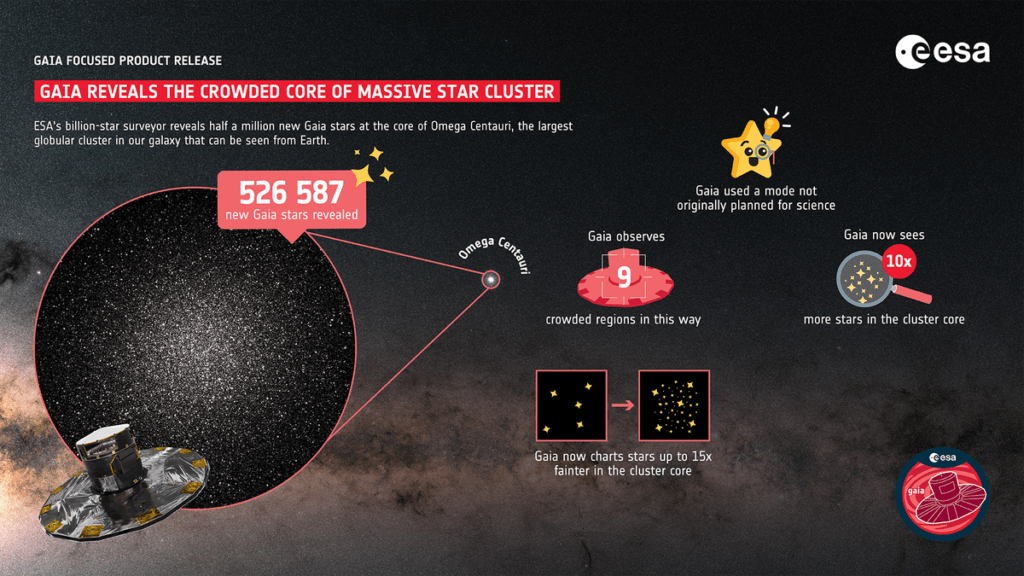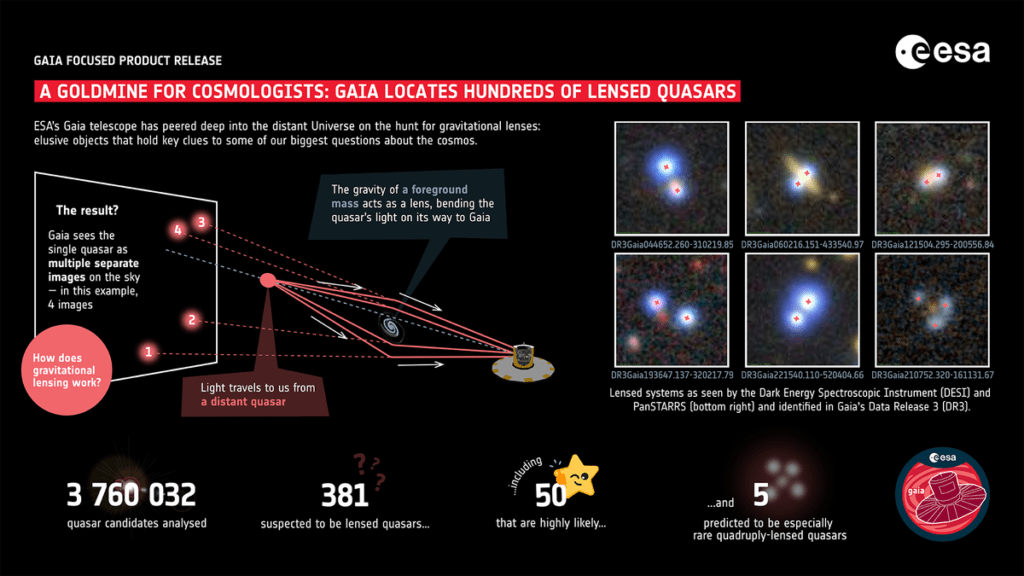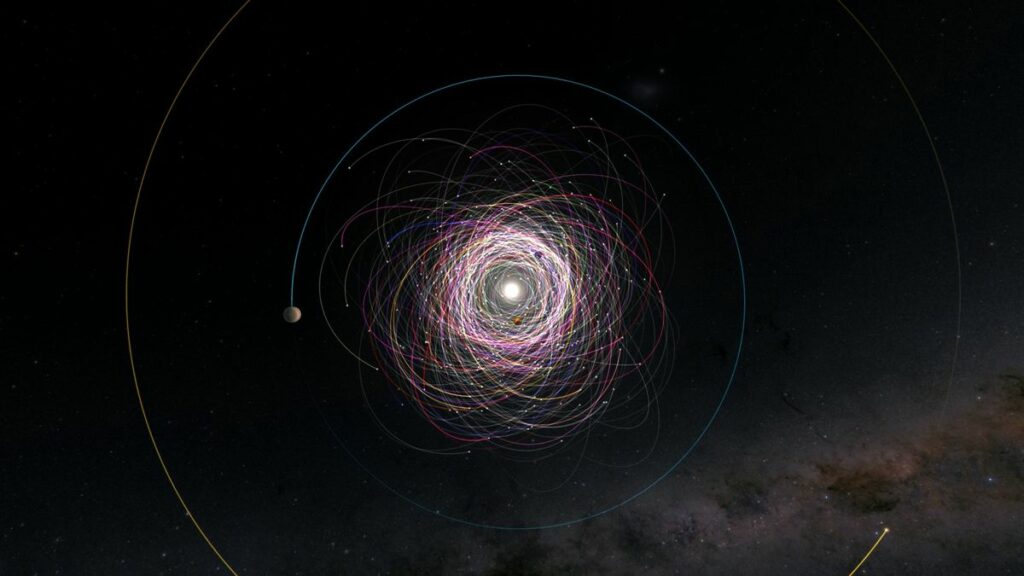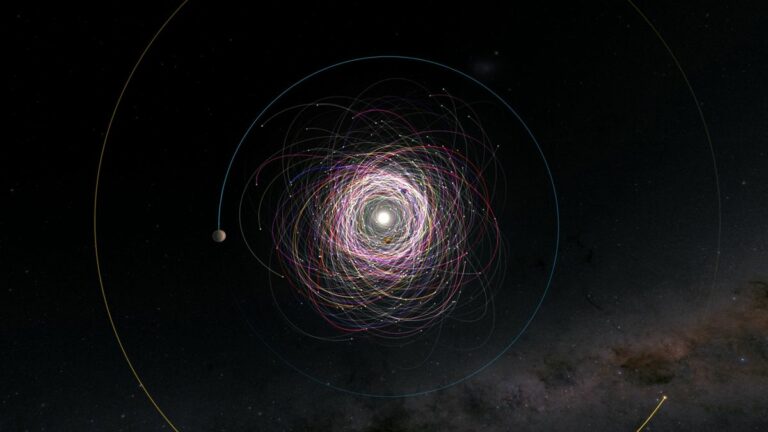New Data from the Gaia Telescope Uncovers a Rich Vein of Over 500,000 Previously Unidentified Stars and Beyond
The European Space Agency’s space telescope also detected more than 380 gravitationally lensed quasars and meticulously charted the paths of over 150,000 asteroids.
The Gaia mission, in its pursuit of assembling the most extensive stellar catalog ever, has unveiled a wealth of fresh insights about celestial objects. This latest disclosure, referred to as Gaia’s focused product release (FPR), introduces an excess of 500,000 new faint stars, more than 380 recently discovered gravitationally lensed quasars, and the precise positions of over 150,000 asteroids within our solar system.
With data encompassing 1.8 billion stars, the all-encompassing map of the Milky Way galaxy and its cosmic vicinity, meticulously constructed by Gaia, will empower scientists to delve deeper into the annals of our cosmic past. This recent release fills crucial gaps within this unfolding map. According to the European Space Agency (ESA), Gaia’s operators, the newly acquired data yields unexpected scientific discoveries that transcend the telescope’s original objectives.
This fresh collection of research extends the work initiated with the third Data Release (DR3) from Gaia, which was made available in June 2022. Despite its comprehensiveness, DR3 had certain areas in the celestial sphere that remained unmapped by the space telescope. Additionally, it omitted certain dim stars that lacked the brilliance of their neighboring stellar counterparts.
A notable illustration of this is found in globular clusters, ancient celestial entities with densely packed cores of brilliant stars. These dense cores can pose a challenge for telescopes aiming to observe them because they tend to overshadow the surrounding stars.
Beyond addressing uncharted areas in Gaia’s cosmic chart
Part of the latest data release from the stellar surveyor space telescope was centered on Omega Centauri, the Milky Way’s most massive globular star cluster, boasting approximately 10 million stars. This cluster’s core represents the most densely populated region ever scrutinized by the telescope.
To address the gaps in its data, European Space Agency (ESA) astronomers aimed Gaia at Omega Centauri, situated at a relatively proximate distance of around 15,800 light-years from Earth. This cluster was employed as a proxy for studying similar clusters.
The lead researcher and a member of the Gaia collaboration, Katja Weingrill, expressed their excitement, stating, “In Omega Centauri, we identified over half a million previously unseen stars that Gaia had not previously detected—all from just one cluster!”
Instead of focusing on individual stars within the cluster, which is Gaia’s usual specialty, the space telescope employed a special observation mode, enabling it to capture a broader view of the sky surrounding the core of the globular cluster during each appearance. Consequently, these fresh observations also served to evaluate the performance of this specialized mode and Gaia’s instrumentation.
Weingrill added, “We never anticipated using it for scientific purposes, which adds an extra layer of excitement to this outcome.”

While the recent data has significantly improved Gaia’s 3D map of the Milky Way by filling in uncharted areas, it holds intrinsic value for scientists by enhancing their ability to model the Omega Centauri globular cluster.
“Our data has enabled us to identify stars that are so closely packed that Gaia’s regular processing couldn’t measure them accurately,” explained Alexey Mints, a research co-author and member of the Gaia Collaboration. “With this new data, we can delve into the cluster’s architecture, the spatial distribution of its constituent stars, their movement patterns, and more, creating a comprehensive large-scale map of Omega Centauri. This represents the full utilization of Gaia’s remarkable capabilities.”
This latest data release, the Focused Product Release (FPR), offers just a glimpse of what is expected in Gaia Data Release 4 (DR4). Gaia is currently investigating an additional eight regions of the Milky Way in a manner similar to its examination of Omega Centauri. Consequently, by studying cosmic building blocks like Omega Centauri, DR4 could uncover crucial details about our galaxy, including its true age, the precise location of its center, and any past interactions with other galaxies.
Gaia, the gravitational lens seeker
Even though Gaia was not originally designed for broad-scale cosmic exploration, the Focused Product Releases (FPR) from Gaia indicate its potential to reveal critical insights into our understanding of the cosmos as a whole, including its evolutionary history and precise age.
One significant way in which Gaia can contribute to cosmology is by identifying what astronomers refer to as gravitational lenses. These are highly dense objects like star clusters that can magnify the light emanating from distant background sources such as ancient galaxies. This phenomenon is made possible by the principles laid out in Einstein’s theory of general relativity, which posits that massive objects cause a curvature in the fabric of spacetime; the greater the mass, the more pronounced the curvature. When such a massive object lies between Earth and a distant source of light, the light passing through this intermediary object undergoes a “bending” as it makes its way toward us. The extent of this bending is contingent upon the proximity of the light’s trajectory to the mass source. Consequently, light from the same source reaches Earth at varying times, and a single object can appear at multiple locations within the same image.
This effect serves to amplify the distant source, making it possible to observe objects that would otherwise be too remote and faint to detect. The James Webb Space Telescope currently leverages this phenomenon effectively to study some of the universe’s oldest galaxies. Gaia can enhance this effort by identifying more gravitationally lensed objects, particularly quasars, the active cores of galaxies energized by supermassive black holes. Detecting lensed quasars poses a challenge because the multiple images created by gravitational lensing can often overlap, causing a single object to appear blurred in images and leading to potential misidentification.

“Gaia is a true seeker of gravitational lenses. Thanks to Gaia, we’ve come to realize that some of the objects we observe aren’t merely stars, even though they may appear that way,” remarked Christine Ducourant, a research co-author and member of the Gaia collaboration. “In fact, they are distant lensed quasars, which are exceptionally luminous and energetic galactic cores powered by black holes.”
“We are now presenting a list of 381 robust candidates for lensed quasars, including 50 that we consider highly probable. This represents a valuable resource for cosmologists and is the largest batch of candidates ever unveiled in a single release.”
These candidates were chosen from a collection of potential quasar candidates, some of which were initially included in DR3. Among them, five of the lensed objects exhibit the rare phenomenon known as “Einstein crosses.” These intriguing formations occur when the light from a single object appears at multiple locations within the same image, resembling the shape of a cross. In 2021, Gaia identified 12 of these Einstein crosses.
“The remarkable aspect of Gaia is its ability to survey the entire sky, enabling us to identify lenses without the need for prior knowledge of where to search,” noted Laurent Galluccio, a research co-author and member of the Gaia collaboration. “With this data release, Gaia becomes the first mission to conduct a high-resolution, all-sky survey of gravitational lenses.”
This highlights how Gaia could potentially collaborate with the European Space Agency’s Euclid, a mission aimed at investigating dark matter and dark energy, launched in July 2023. Together, they could delve into the enigmatic aspects of the universe, accounting for an estimated 95% of its content. Furthermore, the recent releases from Gaia also underscore the space telescope’s utility in exploring celestial objects much closer to our own cosmic neighborhood.
Monitoring asteroids, red giants, and other celestial objects using Gaia.
A segment of the latest Gaia data releases offers enhanced information about 156,823 Earth-orbiting asteroids initially identified in DR3. These details significantly refine their positions and limit their orbital parameters with a precision twenty times greater than previous measurements.
This heightened accuracy was achieved by Gaia through prolonged observations of these space rocks, almost doubling the duration of monitoring compared to its earlier efforts. The European Space Agency (ESA) anticipates that the forthcoming Gaia data release, DR4, will not only double the count of asteroids observed by the space telescope but will also expand Gaia’s observations of solar system bodies by encompassing comets and even Earth’s satellites.

The latest Gaia data releases also encompass observations of the behaviors of over 10,000 binary red giant stars, establishing this as the most extensive compilation of such stellar entities ever assembled. Additionally, the data contains information about signals originating from gas and dust that drift amidst the stars in the Milky Way’s disk.
“Although Gaia’s primary mission is centered around surveying stars, it is also delving into a diverse range of objects, from the rocky bodies within our solar system to multiply imaged quasars situated billions of light-years away, well beyond the fringes of the Milky Way,” noted Timo Prusti, the ESA Gaia project scientist. “This mission provides a truly unique perspective on the Universe and its constituent objects, and we are fully leveraging its expansive, all-encompassing view of the celestial surroundings.”
The FPR from Gaia takes the form of five papers published on Tuesday, Oct. 10
Do not forget to share your opinion with us to provide you with the best posts !




0 Comments